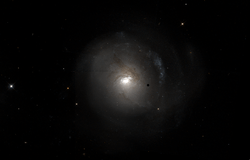NGC 2782
NGC 2782 is a peculiar spiral galaxy that formed after a galaxy merger in the constellation Lynx. The galaxy lies 75 million light years away from Earth, which means, given its apparent dimensions, that NGC 2782 is approximately 100,000 light years across. NGC 2782 has an active galactic nucleus and it is a starburst and a type 1 Seyfert galaxy. NGC 2782 is mentioned in the Atlas of Peculiar Galaxies in the category galaxies with adjacent loops.
| NGC 2782 | |
|---|---|
 NGC 2782 by Hubble Space Telescope | |
| Observation data (J2000 epoch) | |
| Constellation | Lynx |
| Right ascension | 08h 53m 32.7s[1] |
| Declination | 51° 18′ 49″[1] |
| Redshift | 2543 ± 2 km/s[1] |
| Distance | 76 ±34 Mly (23.4±10.6 Mpc)[1] |
| Apparent magnitude (V) | 12.3 |
| Characteristics | |
| Type | SAB(rs)a [1] |
| Apparent size (V) | 3′.5 × 2′.6[1] |
| Other designations | |
| UGC 4862, Arp 215, MCG +07-19-036, PGC 26034, 6C B091051.3+401928[1] | |
Structure

Active galactic nucleus
The nucleus and circumnuclear region of NGC 2782 display starburst activity, with bar of the galaxy providing gas to the nucleus.[2] The active galactic nucleus is hidden by a compact high-column-density absorber and a H2O maser is associated with it.[3] The vigorous star formation creates an unusual "superwind" of out-flowing gas, which has been detected in X-rays as a bubble like structure, approximately 7 arcsec south of the central region of the galaxy.[4] A similar bubble can be seen in radiowaves at the north side.[3] There is also diffuce X-rays emission. The nucleus of NGC 2782 is a low luminosity active galactic nucleus.[4]
Tidal tails
NGC 2782 shows two tidal tails, directing to opposing directions. As depicted in HI imaging, a plume extends about 5 arcmin toward the northwest, with estimated mass 1.4×109 M☉ of atomic hydrogen, accounting for about 40 percent of the total HI mass of the system. A shorter HI plume extending toward the east has been associated with the stellar tail which extends 2.7 arcmin toward the east in the optical images. The northwest tail is fainter in the optical spectrum.[5] CO was detected in the eastern tail, underlying the presence of molecular gas and HII regions in the region, with total mass 6×108 M☉ or even more. There is starformation activity in the eastern tail.[6] In the western tail have been detected 7 UV sources. These stellar populations are 1 to 11 million years old. Three of them have high metallicity, similar to that of the nucleus of the galaxy.[7]
Ultraluminous X-ray sources
Via observations by the Chandra X-ray Observatory, 27 X-ray point sources, of which 13 are ultraluminous X-ray sources (without counting the central one), were observed near the nucleus and are likely associated with the galaxy. This number is unusually high for a galaxy, although ultraluminous X-ray sources are common in starburst galaxies. Sixteen of these sources have a visual counterpart.[4]
Nearby galaxies
NGC 2782 is the largest galaxy in a small group of four galaxies. Nearby galaxies include UGC 4867 and UGC 4871 and further away lie NGC 2785 and UGC 4889.[8]
References
- "NASA/IPAC Extragalactic Database". Results for NGC 2782. Retrieved 2016-01-18.
- Alvarez-Alvarez, M.; Diaz, A. I.; Terlevich, E.; Terlevich, R. (22 June 2015). "A comprehensive photometric study of circumnuclear star-forming rings - I. The sample". Monthly Notices of the Royal Astronomical Society. 451 (3): 3173–3191. arXiv:1311.1653. Bibcode:2015MNRAS.451.3173A. doi:10.1093/mnras/stv1123.
- Zhang, J. S.; Henkel, C.; Kadler, M.; Greenhill, L. J.; Nagar, N.; Wilson, A. S.; Braatz, J. A. (May 2006). "Extragalactic H2O masers and X-ray absorbing column densities". Astronomy and Astrophysics. 450 (3): 933–944. arXiv:astro-ph/0512459. Bibcode:2006A&A...450..933Z. doi:10.1051/0004-6361:20054138.
- Bravo-Guerrero, Jimena; Stevens, Ian R. (10 February 2017). "Superwind evolution: the young starburst-driven wind galaxy NGC 2782". Monthly Notices of the Royal Astronomical Society. 467 (4): 3788. arXiv:1702.03282. Bibcode:2017MNRAS.467.3788B. doi:10.1093/mnras/stx327.
- Smith, Beverly J. (September 1991). "The discovery of a long H I plume near the peculiar galaxy NGC 2782 (ARP 215)". The Astrophysical Journal. 378: 39–46. Bibcode:1991ApJ...378...39S. doi:10.1086/170405.
- Smith, Beverly J.; Struck, Curtis; Kenney, Jeffrey D. P.; Jogee, Shardha (March 1999). "The Molecule-rich Tail of the Peculiar Galaxy NGC 2782 (Arp 215)". The Astronomical Journal. 117 (3): 1237–1248. arXiv:astro-ph/9811239. Bibcode:1999AJ....117.1237S. doi:10.1086/300785.
- Torres-Flores, S.; de Oliveira, C. Mendes; de Mello, D. F.; Scarano, S.; Urrutia-Viscarra, F. (21 April 2012). "NGC 2782: a merger remnant with young stars in its gaseous tidal tail". Monthly Notices of the Royal Astronomical Society. 421 (4): 3612–3621. arXiv:1201.3927. Bibcode:2012MNRAS.421.3612T. doi:10.1111/j.1365-2966.2012.20589.x.
- Makarov, Dmitry; Karachentsev, Igor (21 April 2011). "Galaxy groups and clouds in the local (z∼ 0.01) Universe". Monthly Notices of the Royal Astronomical Society. 412 (4): 2498–2520. arXiv:1011.6277. Bibcode:2011MNRAS.412.2498M. doi:10.1111/j.1365-2966.2010.18071.x.
External links
| Wikimedia Commons has media related to NGC 2782. |
- NGC 2782 on WikiSky: DSS2, SDSS, GALEX, IRAS, Hydrogen α, X-Ray, Astrophoto, Sky Map, Articles and images